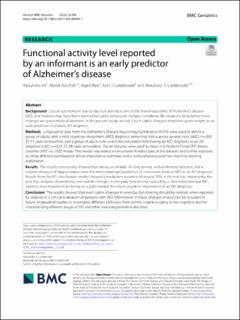| dc.contributor.author | Vik, Alexandra | |
| dc.contributor.author | Kocinski, Marek Michal | |
| dc.contributor.author | Rye, Ingrid Karlsen | |
| dc.contributor.author | Lundervold, Astri J. | |
| dc.contributor.author | Lundervold, Alexander Selvikvåg | |
| dc.date.accessioned | 2023-09-07T12:56:57Z | |
| dc.date.available | 2023-09-07T12:56:57Z | |
| dc.date.created | 2023-05-16T14:11:35Z | |
| dc.date.issued | 2023 | |
| dc.identifier.citation | BMC Geriatrics. 2023, 23 (1), . | en_US |
| dc.identifier.issn | 1471-2318 | |
| dc.identifier.uri | https://hdl.handle.net/11250/3087949 | |
| dc.description.abstract | Background Loss of autonomy in day-to-day functioning is one of the feared outcomes of Alzheimer’s disease (AD), and relatives may have been worried by subtle behavioral changes in ordinary life situations long before these changes are given medical attention. In the present study, we ask if such subtle changes should be given weight as an early predictor of a future AD diagnosis. Methods Longitudinal data from the Alzheimer’s Disease Neuroimaging Initiative (ADNI) were used to define a group of adults with a mild cognitive impairment (MCI) diagnosis remaining stable across several visits (sMCI, n=360; 55-91 years at baseline), and a group of adults who over time converted from having an MCI diagnosis to an AD diagnosis (cAD, n=320; 55-88 years at baseline). Eleven features were used as input in a Random Forest (RF) binary classifier (sMCI vs. cAD) model. This model was tested on an unseen holdout part of the dataset, and further explored by three different permutation-driven importance estimates and a comprehensive post hoc machine learning exploration. Results The results consistently showed that measures of daily life functioning, verbal memory function, and a volume measure of hippocampus were the most important predictors of conversion from an MCI to an AD diagnosis. Results from the RF classification model showed a prediction accuracy of around 70% in the test set. Importantly, the post hoc analyses showed that even subtle changes in everyday functioning noticed by a close informant put MCI patients at increased risk for being on a path toward the major cognitive impairment of an AD diagnosis. Conclusion The results showed that even subtle changes in everyday functioning should be noticed when reported by relatives in a clinical evaluation of patients with MCI. Information of these changes should also be included in future longitudinal studies to investigate different pathways from normal cognitive aging to the cognitive decline characterizing different stages of AD and other neurodegenerative disorders. | en_US |
| dc.language.iso | eng | en_US |
| dc.rights | Navngivelse 4.0 Internasjonal | * |
| dc.rights.uri | http://creativecommons.org/licenses/by/4.0/deed.no | * |
| dc.title | Functional activity level reported by an informant is an early predictor of Alzheimer’s disease | en_US |
| dc.type | Peer reviewed | en_US |
| dc.type | Journal article | en_US |
| dc.description.version | publishedVersion | en_US |
| dc.rights.holder | © The Author(s) 2023 | en_US |
| dc.source.pagenumber | 15 | en_US |
| dc.source.volume | 23 | en_US |
| dc.source.journal | BMC Geriatrics | en_US |
| dc.source.issue | 1 | en_US |
| dc.identifier.doi | 10.1186/s12877-023-03849-7 | |
| dc.identifier.cristin | 2147859 | |
| dc.source.articlenumber | 205 | en_US |
| cristin.ispublished | true | |
| cristin.fulltext | original | |
| cristin.qualitycode | 1 | |

